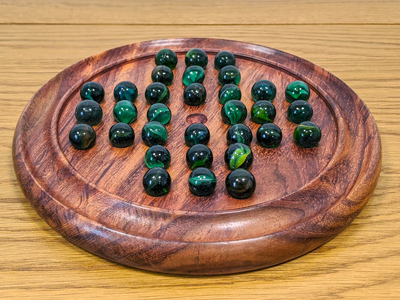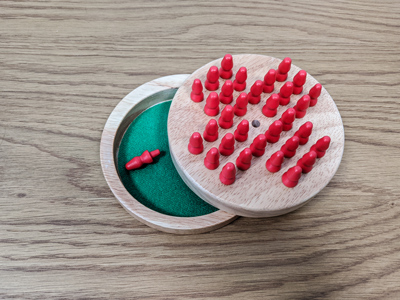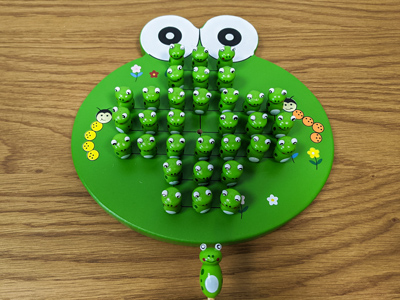Solitaire Board Game
A one-person game that takes no time to learn, but is a real challenge to succeed!
Understanding Solitaire: The Board Game
Solitaire, often misunderstood as a card game, is a captivating single-player board game played with pegs or marbles on a wooden board.
This board game version consists of 32 marbles on a wooden board with 33 dents. Variations may include pegs, plastic instead of wood, and extra holes for added complexity.
LEARN ABOUT THE BENEFITS OF LEARNING THROUGH QUIZZES
Playing the Board Game Solitaire
The game begins by placing 32 marbles in 32 dents, leaving the central dent empty. The objective is to eliminate all marbles, leaving only one, and that final marble must land in the centre dent.
To remove a marble, move one over another, landing in an empty dent. Marbles can move up, down, left, or right but not diagonally.
Solitaire's Educational Benefits
- Solitaire enhances strategic thinking, fostering logical thought in young minds.
- Develops spatial reasoning skills.
- Introduces the concept of algorithms.
- Encourages pattern recognition in children.
- Improves decision-making based on reason.
Rules of the Game
- Place each marble in a dent at the start, excluding the centre dent.
- Move one marble at a time by jumping over another marble into an empty dent.
- Multiple jumps are allowed in one move, similar to draughts.
- Continue jumping until only one marble remains on the board.
- The last marble must end up in the centre dent.
- The game concludes when no more jumps are possible.
Watch our video for a quick tutorial.
Solitaire is a game that teaches various aspects related to maths, reasoning, and logic.
Exploring Solitaire: Cost and History
Standard Solitaire games typically cost between £10 and £15. There are, however, more luxurious versions available, such as one on Amazon for over £100 with semi-precious marbles, making for an exquisite centrepiece on an oak dining table.
The Game's Historical Roots
Evidence suggests Solitaire dates back to at least 1697, as depicted in an engraving showing the Princess of Soubise playing the game. With a consistent format (a board with 32 marbles) and strategic elements, Solitaire likely has a long and enduring history.
FIND OUT WHY KIDS LOVE OUR WEBSITE
Countless Variations
Due to the game's lack of copyright, numerous versions of Solitaire exist, featuring round, square, and even triangular boards. While most use marbles, some opt for pegs. Child-friendly versions with themed pieces, like ladybirds or frogs, are also available.
Below are reviews of three selected variations:
Shalinindia 9” Solitaire Board Game (Cost £12.99)

This is the most usual size for the game – its diameter is just under 23cm.
Round wooden board with lipped edge to hold captured marbles.
Marbles come in a handy storage bag which is very useful.
Many manufacturers make almost identical, well-constructed games.
The one we bought and demonstrated in the video was manufactured by Shalinindia.
Gibsons Mini Solitaire (Cost £9.99)

A miniature version, useful when travelling and to take on holidays.
Diameter of the board is just under 12cm. The pegs are bright red and shaped well for fingers to grasp.
No lipped edge, but it comes as a round box where you can store the pegs inside.
Good quality as you would expect from Gibsons.
Even though it’s a small version, the housing of the pegs within the box makes it our favourite – easy to store, easy to keep pegs with the board and easy to transport (such as the garden on a summer’s day).
Legler Child-Friendly Wooden Solitaire (Cost £14.18)

A delightful version. The board is shaped like a frog’s face and the pegs are little wooden frogs, all with smiling faces!
Board size is 22cm x 20cm x 4.5cm (the extra 2cm are for the frog’s eyes!)
Made of wood, so is robust and less likely to break than plastic.
The board is boxed so you can store the frog pegs inside.
If you’re looking for a fun version for your child to learn, this one fits the bill nicely.
Reminder: A subscription to Education Quizzes allows up to 6 children to play over 3,000 online quizzes for just £9.99 per month. Subscribe
Conclusion
Solitaire offers a unique blend of entertainment and cognitive development. Whether played for educational purposes or pure enjoyment, its enduring appeal is evident. As you explore the diverse versions available, each brings its own charm, making Solitaire a timeless classic in the world of board games.



